Shevlin Sebastian's Blog, page 104
August 31, 2015
Can't See, but Can Play Football
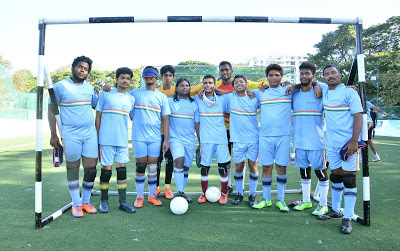
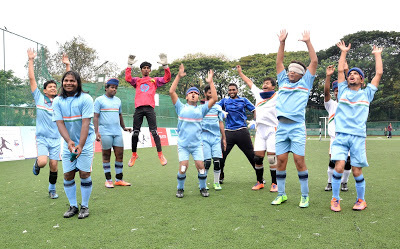 Several youngsters from all over India will be part of the Indian blind football team which is taking part in the Asian Championships at Tokyo
Several youngsters from all over India will be part of the Indian blind football team which is taking part in the Asian Championships at TokyoBy Shevlin Sebastian
Photos by Ratheesh Sundaram
At 6.30 p.m., on a balmy August day, it is getting dark at the astro-turf ground of the Regional Sports Centre at Kochi. But Malaysian Technical Advisor Loo Wai Keong is just getting warmed up. Twelve boys are standing one behind the other at one side of the ground.
Loo picks up the ball and throws it at the lead player, Mohammed Azharuddin. He collects the ball and moves forward. As he comes closer, Loo shouts “Move to the right.” Mohammed moves to the right. Loo then shouts, “Shoot.” And Azharuddin does so. The ball hits the top-right corner of the net. “Well done,” says Loo.
When Abhimanyu Naskar comes forward, the coach shouts at him in English. But Abhimanyu knows only Hindi. At once, the Dehra Dun-based physical instructor, Naresh Singh, says, “The coach is telling you to move faster. Otherwise, the defender will take the ball away from you.”
From a distance, this would seem like a regular workout for a football match. But at close quarters, you can get a shock. All the players are blind.
They have come from places like Delhi, Dehradun, Mumbai, Kolkata, Jodhpur and Kochi. And all of them are training to represent India in the Asian Championships, which is being held in Tokyo, between September 2 and 7.
The team is being mentored by the Kochi-based Society for Rehabilitation of the Visually Challenged (SRVC) and the Indian Blind Sports Association (IBSA). Says Brand Ambassador Shriya Saran, “The Asian Championships will provide a great exposure for the Indian team.”
Incidentally, five-a-side blind football has its own rules: four players should be B1 (fully blind), while the goalkeeper can be B3, which means he can have partial sight, or be fully sighted. The Indian team has two sighted goalkeepers in Sanjay Saji and Melson Jacob.
The area of play is 40 x 20 metres. There are cushioned boards placed on all sides so that the ball does not go out. It also prevents players from hurting themselves. “Before the match, the referee places three layers of bandage on the players to create total darkness, as some may have a slight perception of light,” says MC Roy, Project Head, SRVC. “A game lasts 50 minutes, with a break of 10 minutes. During a match, players can be substituted any number of times.”
As for the ball, it is smaller than a football. “It does not bounce as much,” says Indian coach Sunil Mathew. “In fact, it is slightly heavier because there are ball bearings inside it. The sound is audible to the people who are playing.” Before the start, the coaches of the two team stand at the sidelines. As the match progresses, they shout frantic instructions to the players.
Meanwhile, when a defender approaches a player who has the ball, he has to keep shouting “Voie, Voie.” Sometimes, there is a collision. Many players have suffered injuries on the arms, knees and face. To counter that danger, centre-forward MD Salim Khan plays aggressively.
By the way, the concept of an Indian football team came to Sunil accidentally. One day, when he doing research on the Internet he came across an astonishing statistic. “A country like Brazil, with a population of 198 million, has 660 visually-challenged football teams, while India, with a population of 1.2 billion, has never put up five people for a tournament,” he says. “That was the impetus for SRVC and the IBSA to form a team.”
But to take part in the Tokyo championships, it was a generous grant from the Tata Trusts in Mumbai which tilted the scales.
Biswanath Sinha, Associate Director of Tata Trusts, says, “We want to champion the cause of the visually challenged -- their right to sports, entertainment and a quality life like every other human being.”
(An edited version appeared in Sunday Magazine, The New Indian Express, South India and Delhi)
Published on August 31, 2015 22:46
August 30, 2015
One Corner of the Indian Field
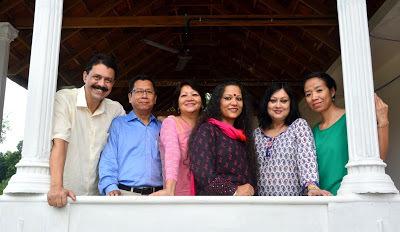 At an international literary festival in Kerala, writers from the North-East talk about their experiences
At an international literary festival in Kerala, writers from the North-East talk about their experiencesPhoto: (From left): Dhruba Hazarika, Robin Ngangom, Streamlet Dkhar , Nitoo Das, Mitra Phukan and Rita Krocha. Photo taken by Ratheesh Sundaram
By Shevlin Sebastian
When Khasi writer Streamlet Dkhar came to know that there would be a photo shoot, she said, “I will come dressed in my traditional costume, the Jainsem Dhara.” And she did. It was in a peach colour. The Jainsem consists of two pieces of material, worn on top of a blouse, with the two ends tied to both shoulders.
The shoot took place at Chengannur, 100 kms from Kochi, where an international literary festival, organised by the South India Writers' Ensemble, took place.
Streamlet has written 17 books, a mix of plays, poetry, fiction and criticism. In her poetry, she has focused on Khasi folk tales. However, in the book, 'Clouds of Emotions', Streamlet focused on a serial bomb blast in Guwahati, well as the terrorist attacks in Mumbai, both of which took place in 2008.
“Most of the poems are about guns, terrorists and innocent victims,” says Streamlet, who is head of the department of Khasi at the North-East Hill University at Shillong.
Asked whether the people are interested in literature, she says, “It was only in the mid-18th century that Khasi got a written script, when we adopted the Roman script brought by Thomas Jones, the Welsh Calvinist Methodist missionary. But our oral tradition is very strong.”
Interestingly, many people in Chengannur asked her about her name. “I was a pre-mature baby, and very small, like a streamlet,” she says. “So that is how my father gave me that name.”
Manipur has diverse communities like the Nagas, Kukis, and the Meiteis. “But the Nagas have differences with the Kukis and the Meiteis,” says Robin, an Associate Professor of Literature at North-East Hill University. “There is a lot of violence.”
Author Mitra Phukan of Assam agrees. “Last year, there were so many killings,” she says. “Our society has become desensitized. Numbers matter now. If only one person is killed it is 'fine'. And that is horrible. The most terrible thing happened during an Independence Day parade of school children at Dhemaji in 2004. There was a bomb blast by ULFA (United Liberation Front of Asom). Many children and mothers were killed. This disturbed everybody in society.”
Mitra, who has written eight books of fiction and non-fiction, is best known for her novel, 'The Collector's Wife'. The background is the student agitation in the 1980s and the beginnings of the insurgency.
Mitra says that despite all the problems, literature is thriving in Assam. “There is poetry, essays and novels which talk about the suffering of the people,” says Mitra. “The thing about good literature is it that it is not judgemental. It speaks of the anguish of the perpetrators as well as the victims.”
In Nagaland, there is not much of an environment for literature. But a few years ago, a beginning was made at the Hornbill festival, at Kisama, which showcases tribal culture. “There is a Hornbill Literature Fest, where writers have found a bit of space,” says Rita.
Meanwhile, at Chengannur, Assamese writers Dhruba Hazarika and Nitoo Das tried to dispel the myth that the North-East is one big mass of collective thinking. “The North-East is a mini India,” says Dhruba. “There are 126 dialects and languages and more than 200 tribes.” Adds Nitoo: “The cuisine, language and culture differ from state to state, and there are excellent writers in so many different languages. It makes the region a fascinating place.”
(Published in the Sunday Magazine, The New Indian Express, South India and Delhi)
Published on August 30, 2015 21:47
August 23, 2015
The Master Of Strings
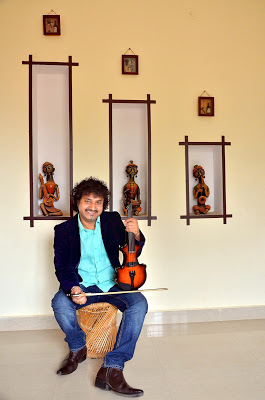
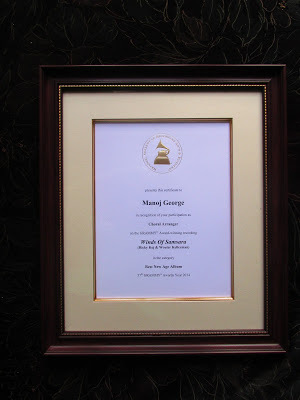
 The Thrissur-born Manoj George is the first Indian violinist to be awarded a Grammy certificate for his work on the New Age album, 'Winds of Samsara'. He talks about his life and career
The Thrissur-born Manoj George is the first Indian violinist to be awarded a Grammy certificate for his work on the New Age album, 'Winds of Samsara'. He talks about his life and careerBy Shevlin Sebastian
Photo of Manoj George by M. Jithindra
Violinist Manoj George had gone to Pune in February, 2014, to take part in a show with the singer Lucky Ali. After the show was over, he was sitting in the green room, when one of the organisers came up to him, and said, “Somebody wants to meet you.”
So Manoj stepped outside. A pregnant woman, in her early thirties, and wearing a salwar kameez, smiled at him. She said, “It was a good programme. But when I saw your performance, I have decided that I will make my unborn baby a violinist.”
On a brief visit to Kochi, the Bangalore-based Manoj says, “I felt shocked. In fact, this is one of the most unforgettable compliments I have received.”
There is a glow on his face as he speaks. Of course, Manoj has other reasons to have a glow. In February, the album, 'Winds of Samsara', a collaboration of the Bangalore-based composer Ricky Kej and the South African flautist Wouter Kellerman, won the Best New Age Album at the 57th Grammy Awards. And Manoj contributed for two songs: he did the choral arrangement for 'Mahatma', and the orchestral arrangement for 'Mountain Solitude'.
Amazingly, for his choral arrangement work, he was given a certificate from the Grammy Awards. “It was a proud moment for me,” he says. Manoj may be one of the first Malayalis to get this award, as well as the first Indian violinist.
The certificate is rare because although 120 musicians worked on the album, only a handful got this honour. Not surprisingly, Manoj has framed it and put it up on a wall in his house at Bangalore.
'''Winds of Samsara' is a fusion of contemporary music from all over the world,” says Manoj. “So, there is a mix of Western and Indian classical music, South African and Middle East genres of music. It is a spiritual and meditative album.”
And it did well. The album reached No 1 in the Billboard New Age charts. But even before it was released, Manoj had no doubts that it would do well. “Just after I finished recording 'Mountain Solitude' in a recording studio at Bangalore, I noticed that everybody went quiet,” he says. “It seemed as if they had gone into a zone of silence and peace. That was when I realised that 'Samsara' would make an impact.”
Manoj has also made an impact. A talented artist, he has performed in Europe, Africa, the USA, Canada, the Middle East, China, and Sri Lanka. He has his own band, 'ManojGeorge4Strings', and played with musicians like Dr L Subramaniam, Hariharan, Shivamani, Shankar Mahadevan, Trilok Gurtu, and rock musician Bryan Adams.
Apart from that he has composed music for Malayalam films like 'Kharaksharangal' and the Kannada film, 'Aathmeeya'. “In films, music composers have less freedom,” says Manoj. “It is the director who decides what type of music they want.” Meanwhile, in Bangalore, Manoj has set up the New Wave Music Centre with the aim of developing a new generation of musicians.
Manoj's own foray into music began in his hometown of Olarikkara in Thrissur district. He got inspired to learn the violin when he saw the violinist, John Lewis, playing in the choir of the Little Flower church. “I liked the sound,” he says. “Many people think that the violin is a sad instrument, but I don’t agree. It has a lot of variety.”
When he told his father, George Chittilappilly, who wrote lyrics and poems, the latter offered full encouragement. So Manoj joined the Kalasadan orchestra and came under the tutelage of Leslie Peter.
“I liked the instrument, but I realised that it is not easy to play,” says Manoj. “So I practiced a lot.”
The Kalasadan was one of the best orchestras in Thrissur. So it was no surprise that Manoj wanted to be a part of it.
Three years after he began playing, one day, Leslie asked Manoj whether he would like to play the violin for one of the shows. “That was the moment I was waiting for,” says Manoj. “I immediately said yes.” And he has never looked back.
Today, Manoj is busy as ever. “I am working on a solo violin album,” he says. Manoj is also collaborating with Poly Varghese, who has studied under veena exponent Pandit Vishwa Mohan Bhatt. “I am also doing live shows, which is a blend of music and dance,” he says. “In these shows, the music is not an accompaniment to the dance. Rather, it is a jugalbandi between music and dance.”
A full-time violinist for the past 25 years, Manoj also has words of advice for budding musicians. “Firstly, you need to have talent,” he says. “In any field there will be lots of competition. But hard work will always be rewarded. However, you have to struggle a lot. There will be moments when you feel dejected. But, today, I have no regrets because I am living my passion. I thank God for that. If I get a chance to re-live life I want to be Manoj George and a violinist once again.”
(Published in The New Indian Express, Kochi and Thiruvananthapuram)
Published on August 23, 2015 23:13
August 18, 2015
A German Viewpoint
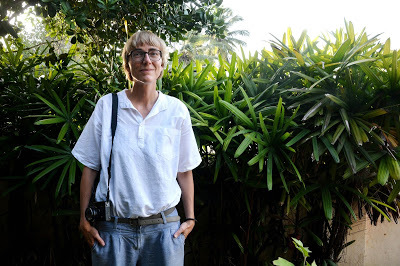

Sabine Schrunder talks about concept photography and her experiences in India
By Shevlin Sebastian
Photo of Sabine by Ratheesh Sundaram; Sabine Schrunder putting a colour on the shadow of a man
On a lazy August afternoon, German photographer Sabine Schrunder went to the Vypeen Islands. She began walking along a path besides the water. There was nobody around. An afternoon breeze was blowing. At some distance away, she saw an old man. He stared at Sabine. She thought he was a beggar.
But when she came close, he gestured that he could take Sabine on a boat ride. Sabine was not sure whether it was safe. Nevertheless, she asked how much. The man showed a forefinger. So Sabine paid him Rs 100 and then got onto the boat. Then she said, “I am Sabine.” Then the man gestured with his hands that he was deaf and dumb.
After a while, he rowed to another part of the island. Then he took Sabine to his house. “His wife confirmed to me that he was physically disabled,” says Sabine. “Then she shocked me by saying he is only 50 years old. He looked 70 to me. Maybe the difficulties of life had aged him. They showed me photographs of the family. And then the boatman took me back to the place where we started the journey.”
For Sabine, it was an unusual and moving experience. “I realised that I have a privileged life,” says the Berlin-based photographer. At present, Sabine is a resident artist at Pepper House, Fort Kochi, and has been taking a workshop for students at the RLV College of Music and Arts.
“I told participants the concept of photography as story-telling,” says Sabine. “Most of the students are working on solitary images. They try to capture a nice moment. But that is a conventional style. I asked them to work on a theme and take several photos illustrating it.Photography's biggest strength is to tell something behind the picture. This is known as concept photography.”
Sabine was happy to note that the participants were open-minded. “They told me that it was a new world that they were seeing,” she says. “I want to give them a push in a different direction. Sadly, in India, you cannot study photography as a separate degree. It is one subject in applied arts. But I have spent six years learning only photography.”
And she is good at it. Sabine has won several awards, and honours, including the prestigious Haselblad Masters Awards Prize in 2008. Today, she is a teacher at the 150-year old Lette Foundation in Berlin. “I love teaching and talking with young people,” she says. “I feel I can inspire them.”
Asked about the qualities needed to be a good photographer, Sabine says, “You have to be curious, ask questions, and search for the deeper meaning of everything.”
This search for a deeper meaning has led German photographers to develop a sharp attitude towards everything. “So they try to focus on a topic that looks at society critically,” says Sabine. “I am doing a theme on the individual being bound by the structures of society. I am not searching for the beautiful photo. In Germany, we have gone past that stage.”
Sabine had come to India at the invitation of the Goethe Institut, which is a part of the Max Mueller Bhavan in Bangalore. “My initial days in Bangalore were mind-blowing,” she says. “The colours and smells were so different. For the first time I saw cows and goats moving around on the streets. But, soon, I began to enjoy it. It was inspiring. And then when I came to Kochi, it was so green. The people are friendly and warm-hearted. I felt so welcome, even in Fort Kochi, where there are so many tourists.”
And one day, she had an unexpected experience. A few members of the production crew of the Dulquer Salman starrer, 'Charlie', met her at Pepper House. They asked Sabine if she had five minutes to spare. A curious Sabine agreed. So, she was taken to the first floor of a house in Fort Kochi. It was a film set. “There were lights, cameras and people everywhere,” says Sabine. “The main actress, Parvathy, introduced me to everybody and then told me about my role. I had to look at a door, feel surprised, say something, and leave.”
Meanwhile, sometime earlier, she had also gone to Thiruvananthapuram to conduct a workshop. While there, Sabine saw an electric pole, during a hot afternoon, giving out a long shadow. So, she decided to colour the shadow with the powder that you use to make sindhoor. Soon, a man started watching Sabine work. So, she coloured his shadow. Other men and an old woman appeared. “One person told me to hurry up since the sun was moving away,” says Sabine, with a smile. “In the end I took photos. This is one example of concept photography. Everybody looked pleased with my efforts.”
But it is not all pleasing experiences for Sabine. “Seeing the garbage at the Fort Kochi beach is heart-breaking,” she says. “One day, while travellling on the ferry, I saw a woman throw a plastic bottle into the water. We would never do this in Germany. We usually use the dustbin.”
And she is taken aback by the lack of physical freedom for women. “In Germany, it is normal for men and women to be out late at night,” she says. “Sometimes, the women are alone. But here it is not so common. It is a different culture altogether.”
(Published in The New Indian Express, Kochi and Thiruvananthapuram)
Published on August 18, 2015 21:25
August 16, 2015
A Smooth Swim
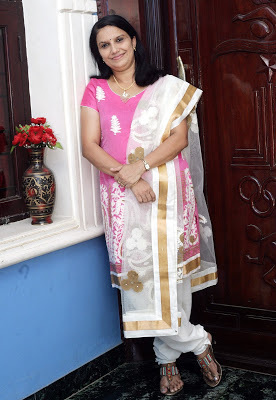
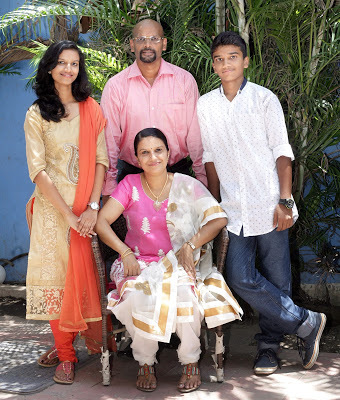 COLUMN: Spouse's Turn
COLUMN: Spouse's Turn Molly Chacko talks about life with the former swimming champion Sebastian Xavier
By Shevlin Sebastian
Photos by P. Ravikumar
One day, in 1994, champion athlete Shiny Wilson approached her colleague, Molly Chacko, at a training camp in Bangalore, and said, “There is a marriage proposal for you.”
“From whom?” said Molly.
“Sebastian Xavier,” she replied.
Molly said, "I will have to inform my parents about it."
Molly and Sebastian had been friends for a while. “We would speak to each other, because there were so many Malayalis in the training camps at Delhi and Bangalore,” she says. While Sebastian was a swimmer, Molly was an athlete.
After a while, Sebastian's sister, Valsamma, and her husband, Aprem, came to see Molly in Ooty where she was doing high-altitude training. Later, both sets of parents met and finalised the tie-up.
The marriage took place at the St. George Church at Edathua on December 26, 1994. What Molly remembers of that day were the many colleagues who came. They included celebrities like PT Usha and her husband Sreenivasan, Shiny and Wilson Cherian, Padmini Thomas, Sports Minister Pandalam Sudhakaran, Kuttanad MLA, K.C. Joseph, and Molly's mentor, the Dronacharya Award-winning coach KP Thomas.
For their honeymoon, the couple went to Ooty. "I remember we went boating on the lake," says Molly. "Sebastian enjoyed the paddling. It was a new experience for him.”
Today, both are working in the Indian Railways and are settled in Chennai. While Sebastian is a Sports Officer, Molly is an office superintendent.
Asked to list his plus points, Molly says, “Sebastian is a simple person and easily adjusts to different situations. He also has a tendency to help people.”
Sometime ago, when Sebastian’s best friend, an inspector, George Joseph, fell from a train, and died, he was the first to arrive on the scene. Thereafter, he ensured that the post-mortem was done quickly so that the body could be returned to the family for burial.
Among his negative traits is a tendency to get irritated if tasks take long to be completed. “I believe this is because he had been a 50m swimmer, so he likes things to be done quickly,” says Molly, with a smile.
When asked whether she has seen any of Sebastian's races, Molly says, “The first time I saw Sebastian race was at the Bangalore Nationals in September, 1996.” With her two-year-old daughter in tow, Molly had gone from Chennai to see this 50m race. At that time, Sebastian was the national 50m and 100m champion and he was in good form. Before going to Bangalore, Sebastian asked Molly to pray at the St. Antony’s church near their house, so that he could perform better.
The prayers helped. Sebastian set a national record of 22.89 seconds for the 50m which stood for 14 years. In an earlier nationals, at Goa, in 1994, Sebastian won an unprecedented eight gold medals and set six national records. “You just take a breath and Sebastian was across the pool,” says Molly. “That was how fast he was.”
In the end, Sebastian won 66 gold medals at national meets, 36 Asian level medals, and represented India in two Asian Games, several South Asian Games, as well as the 1996 Atlanta Olympic Games. As for Molly, she is the current 3000m national record holder, which she set during the 1994 Asian Games at Hiroshima. She is also a former national record holder in the 1500m.
Meanwhile, Sebastian’s success came at a physical price. He lost all his hair. “That was because he spent long hours in the pool,” says Molly. “Sebastian rarely used a swimming cap while training. So the exposure to chlorine damaged the hair. His teeth as well as his skin also got damaged.”
But Sebastian has accepted this stoically. Like in any sport, there are low and high moments. And the high point for Molly was when Sebastian won the Arjuna Award in 2000. “Sebastian had to wait a long time to get the award,” says Molly. “He was on the short-list three times. There was a lot of politics.”
She accompanied him to Delhi for the awards function at Rashtrapati Bhavan. For the ceremony, Sebastian wore a brown coat, a maroon tie, white shirt and cream trousers. “As he went to collect the award I felt a great joy within me,” says Molly. “The Arjuna Award is the culmination of a good sports career in India. President KR Narayanan gave the award and said, 'Congrats, well done'. KM Beenamol also won that year.”
Interestingly, although Sebastian has won so many honours, because of swimming, he rarely gets into the pool these days. “He likes to play badminton, either in the morning or the evening,” says Molly. “He keeps in touch with swimming by accompanying the Railways team to competitions all over India.”
Back home, he gives company to daughter Elizabeth, 19, and son Mark, 15. “He is not strict, but at the same time, he is not soft,” says Molly. “He likes to play games with them. Sebastian has the heart of a child. When we have free time, we like to go for films. The last film we saw was 'Premam', and we all liked it.”
Finally when asked for tips for a successful marriage, Molly says, “You should have faith in your spouse. My parents instilled a deep belief in God. So I pray a lot. You have to learn to adjust to all sorts of situations. It is not smooth flowing all the time.”
(Published in The New Indian Express, Kochi and Thiruvananthapuram)
Published on August 16, 2015 20:55
August 12, 2015
ASI delays conservation work at St. Francis Church
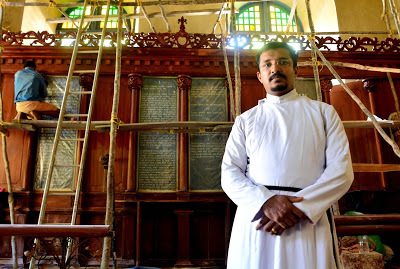
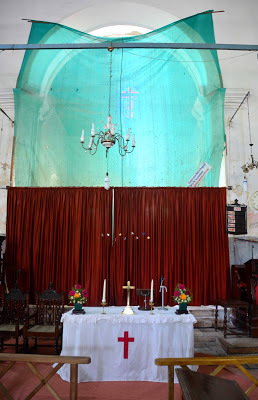
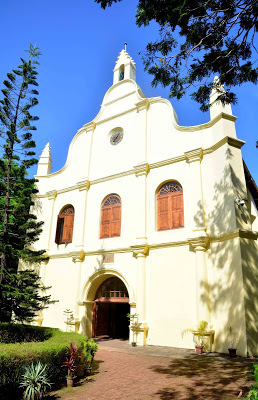 By Shevlin Sebastian
By Shevlin SebastianPhotos by Ratheesh Sundaram
Businessman Kenneth Torres from Sheffield, Britain, shook Fr. Aneesh Kurian's hand, and said, “Why is the work taking so long? The government machinery is very slow.”
In July, 2014, the Archaeological Survey of India (ASI) had begun conservation work on the laterite walls, near the altar, of the 512-year-old St. Francis Church at Fort Kochi. They were also going to restore the wooden altar. The original schedule was six months. But 13 months later, the work is moving at a snail's pace.
Kenneth had come last year when the work had begun. So he was surprised to see that the work was unfinished.
For the parishioners, it has been an inconvenient time. “We have been using a makeshift altar for so long,” says Fr. Aneesh. “Two major celebrations have gone past: Christmas and Easter. The parishioners have asked me to send a petition to the Archaeological department to speed up the work.”
T. Sreelakshmi, superintending archaeologist of ASI, says, “This is an archaeological work. And it will take its own time. It is not replastering that we are doing. We are doing paper pulp treatment. That means, we are trying to extract the salts from the laterite walls. If we don't do that, and plaster the wall, it will be a futile exercise. The climate is also a factor. When there are moisture or wet conditions, it is difficult to work. We need to get the walls dried.”
Fr. Aneesh says the attitude of the ASI is casual and unprofessional. “In the early months, there would be five to six workers every day,” he says. “Now, it is one or two people. Sometimes, no work is being done at all. When we asked the ASI about it, they said that there is a scarcity of labour.”
Sreelakshmi says that they assign the labour depending on the requirements. “Sometimes, we put more people and at other times when we don't require it, there are less number of workers,” she says.
Interestingly, Fr. Aneesh has come to Fort Kochi, following a two-year stint in Goa. “The same ASI has done restoration work in the Basilica of Bom Jesus, [which houses the body of St. Francis Xavier], right on time,” he says. “In many places in Goa, where restoration work is being done, in temples and churches, they finish the work on the scheduled date. Why can't the ASI show the same professionalism in Kochi also?”
Sreelakshmi mentioned the limitations of a government organisation. “We need to get approval for funds allocation,” she says. “Sometimes, we get funds, sometimes we don't. There can be procedural lapses. We tried to complete it within six months, but because of these constraints, the work is still going on. I expect the project to be completed within the next two months.”
As Fr. Aneesh speaks, on a sunny August afternoon, groups of tourists from all over India as well as abroad are coming in. But all that they can see is a large green tarpaulin cloth that covers the altar. “It spoils the viewing experience,” says Fr. Aneesh. On an average, the church gets about 3000 visitors every day.
(The New Indian Express, Kochi)
Published on August 12, 2015 22:01
August 10, 2015
Celebrating A Master

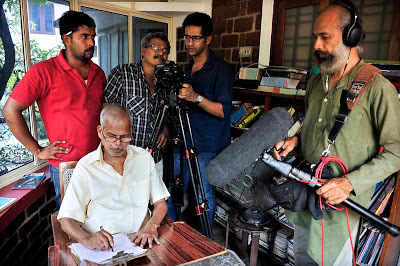 Poet Anvar Ali has made an absorbing documentary on Attoor Ravi Varma, one of the leading poets of modernism in Malayalam literature
Poet Anvar Ali has made an absorbing documentary on Attoor Ravi Varma, one of the leading poets of modernism in Malayalam literatureBy Shevlin Sebastian
Photos: Anvar Ali by Ratheesh Sundaram; Attoor Ravi Varma (seated) during a shoot. Anvar Ali is at centre, behind. Photo by Jiji Alphonse
Here are a few lines:
'When you walk along the Post Office Road,You turn into a handful of blood.A handful of blood spreads like palm,and complains to me.
It screams to me,It comes to catch me,I tell them,I am neither the trigger or the bullet'.
This poem was written in 1989 when the Indian Peace-Keeping Force went to Sri Lanka. “Attoor questioned the passiveness of the Indian liberals, as well as the pseudo-Gandhians in India,” says the film's director Anvar Ali. “It is a poem of prophesy. Lakhs of Sri Lankan Tamils had been killed in the civil war. Those who are alive now are living like animals. There is no food in their colonies. Apart from the suppression of their history, the Tamil writers have been silenced.”
But Anvar has not been silenced. He is a well-known poet in Malayalam literature, who has been an ardent reader of Attoor's work for many years. “We don't have a culture of respecting major writers during their lifetime,” says Anvar. “In fact, the ones who become celebrities tend to be mediocre.”
So, there arose a desire in Anvar to make a documentary on the poet. But he was not sure whether Attoor would say yes since he tended to stay away from the mainstream as well as the media.
One day, in Thrissur, there was a literary meeting. Attoor, 84, a former teacher of Malayalam, had come early. So did Anvar. An intuition prompted Anvar to approach the poet. He said, “Sir, can I ask you something?”
“What is it?” said Attoor.
“Can a film be made on you?” said Anvar.
“Who is going to make it?” he said.
“I am,” said Anvar.
“Then make it,” said the senior poet.
“I felt so happy,” said Anvar.
Anvar re-read Attoor's poems many times, to get a deeper understanding. He did a lot of research. Thereafter, Anvar sent a synopsis to the Sahitya Akademi in Delhi. They have a project to document the lives of India's eminent writers. The Akademi accepted his proposal and provided the funds for making the film. Anvar worked on the script for more than a year before shooting began.
The 90-minute film is sincere, absorbing and respectful. It begins with Attoor sitting on the verandah of his house at dusk, with the lights switched on in the living room behind him. Suddenly, there is a power cut. In the darkness, Attoor launches into a poem called 'Adolescence', which deals with power cuts, and the ensuing silence of televisions and loudspeakers, as well as ‘the ancient song of cicadas tearing up the darkness’.
In fact, Satchidanandan read a few lines from a poem, 'Feeling Cold', which he had dedicated to Attoor. Then young poets Manoj Kuroor, and Kuzhoor Wilson sang a poem by Atoor.
“Attoor's poems have an appeal across many generations,” says Anvar. Attoor himself explained the beauty of the art form. “The language of poetry is the language of our thought,” he says. “There is no language that is so close to one's inner language.”
Although Attoor has written less than 150 poems during his long career, they have been much appreciated. He has won the Sahitya Akademi for poetry as well as translation, the Kerala Sahitya Akademi Award, the Ezhuthachan Puraskaram as well as the Asaan Prize.
The down-to-earth Attoor co-operated very well during the shooting. In one scene, Tamil poet Salma sits on the railing of a verandah at Attoor's home, at Thrissur, while the poet is reclining on a cane armchair. Attoor had translated Salma's poems as well as one of her novels into Malayalam. Salma expressed her happiness to Attoor for doing this. Suddenly, Attoor said, “What is the reaction now to Sri Lankan writers like Cheran?” This question enabled Anvar to cut to the Cheran interview seamlessly.
The film has been screened in the competitive section of the International Documentary and Short Film Festival, at Thiruvananthapuram, and was a curtain-raiser at Thrissur's Vibgyor international film festival. It was also shown recently at the international literary festival, organised by People For Performing Arts And More, at Chengannur.
When asked whether he would make more films, Anvar says, “After 'Maruvili', my friends began calling me a film-maker, but I don't think so. I am a poet. I think verbally, and in the language of poetry.”
(Published in The New Indian Express, Kochi and Thiruvananthapuram)
Published on August 10, 2015 21:40
August 9, 2015
Memories of the Family Helper
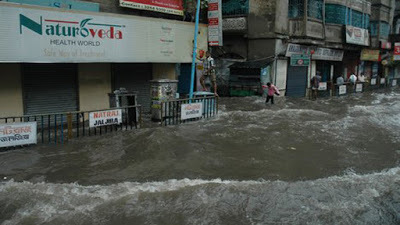 By Shevlin Sebastian
By Shevlin SebastianPhoto: A waterlogged street in Kolkata
On a quiet Sunday afternoon, when I awoke from a nap, at my home in Kochi, a thought came to my mind: where is Mohammed Sabir now? For many years I would see him nearly every day. He worked as a helper in my dad’s office at Kolkata.
He would come every day to our house to collect the keys. The office was a kilometre away, on Shakespeare Sarani. He would open it, clean and sweep the floors. Sabir was a person you could turn to, when you had a problem.
In September, 1978, when flood waters entered our ground-floor flat, because of non-stop torrential rain, he arrived holding an umbrella. Then he helped us by getting bricks from a nearby park. The sofa, tables, beds and the refrigerator were placed on these bricks. As a result, they were not damaged. There was six inches of water in all the rooms. We watched with amused surprise as a neighbour's dog nonchalantly passed urine in our living room.
Sabir was from the Munger district of Bihar. He spoke little about his early life. Apparently, one day, as a teenager, he boarded a train and landed up in Kolkata. After working in several menial jobs, he began working for my father. He liked a regular routine. A short man, Sabir always dressed neatly, with his hair combed backwards, plastered to his head, thanks to the use of oil.
It was not that he was perfect. He liked to have a drink in the evenings. I had no idea how much he drank, but, on some mornings, as a child, I could see that his eyes were red.
Sabir remained unmarried for many years. But one day, he told us he was going home. When he returned, he appeared at our home, with a woman in tow. Zaheeba was two inches taller than Sabir. “We have got married,” he said. “She is from my village.”
The mis-matched couple got along well, and had three sons. They lived in a two-roomed house in a slum a few kilometres away. When I look back, I feel astonished that I never visited his home, although he invited me many times.
And the years went past. Soon, there came a moment when it was time to leave Kolkata. My father had retired and was returning to Kerala. I was also moving to south India.
Since Sabir had worked for us for twenty years, my father gave him a sizeable sum of money. That was when he realized he needed to open a bank account. So my dad helped him fill the forms and he signed his name, in a lopsided manner, and the money was deposited. And then he said a surprising thing, “I have to make sure that my children do not know about this.”
His sons had grown up. Sadly, like their father, they did not study much. One worked as a mechanic, another as a driver, and the third as a factory hand. “They might want the money,” he told my father. So, he hid the cheque and passbooks, under several clothes, at the bottom of a tin suitcase, which was pushed under a bed.
“You will be surprised to know that there comes a day when parents become afraid of their children,” he told me with a sad smile.
We left Kolkata on a wintry December night. I shook Sabir's hand and said goodbye. He had tears in his eyes.
And since then I have lost touch with him. It was a time when mobile phones did not exist. Sabir had no land phone in his house.
And today, years later, I have no idea whether he is alive or dead. Whether he is healthy or sick. Whether he is still working. He should be about 80 now. All these unanswered questions filled my mind on that recent Sunday afternoon.
Indeed, life is a journey. With some people, mostly family members, you remain in touch till the end. With the others, you go along, for a while, then part ways, never to meet again.
(Published as a middle in The New Indian Express, South India editions)
Published on August 09, 2015 21:47
August 8, 2015
The Power of Gems
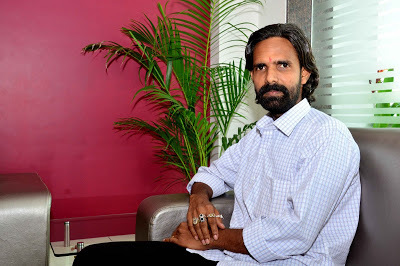
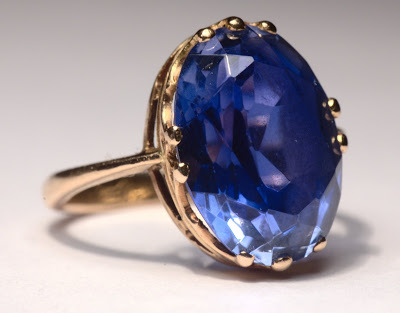

 Gem astrologer K. Sudhish says that the accurate reading of a person's aura can help cure them of illnesses and other problems
Gem astrologer K. Sudhish says that the accurate reading of a person's aura can help cure them of illnesses and other problemsBy Shevlin Sebastian
Photo of Sudhish by Ratheesh Sundaram
Top corporate professional Brijesh Verma was doing well in his career. But he had a nagging sense of sorrow. His 13-year-old daughter had a persistent back pain. He had tried all sorts of treatments, but nothing had worked. “I realised that I needed some divine help,” he says. At that moment, his colleague Naveen told him about a gem astrologer K. Sudhish, who lives in Kochi.
So, in 2012, Brijesh gave Sudhish a call and told him about his daughter's problem. After listening to him intently, Sudhish asked Brijesh to make his daughter wear a sapphire ring. Soon, her pain stopped. An elated Brijesh began to consult for himself. Sudhish asked for his time and date of birth.
“But that is not the most important information for Sudhish,” says Brijesh. “Most astrologers use the date to create a horoscope and work from that. But Sudhish does not do that. He will ask a couple of questions which are physical in origin: 'Do you have a headache?' 'Do you like sleeping in a particular way?' He takes all the inputs to arrive at a broad conclusion.”
Soon, Sudhish told Brijesh to wear a ruby stone. After some time, he suggested a sapphire ring. After wearing the rings for a while, Brijesh was surprised to see that his attitude had become positive minded. “I felt good,” he says. “I believe it is psychological. The first impact is definitely on the mind. I turned from being a negative to a positive person. You start seeing life in a different perspective. Your mind becomes more receptive.”
For three years, Brijesh carried on consulting with Sudhish. And, amazingly, they have not met. All consultations have been done on the phone.
“What I like about Sudhish is his scientific approach,” says Brijesh. “There are astrologers who give confusing explanations about planets. But Sudhish knows about how gems can alter the vibrations in the pressure points of the body.”
Sudhish smiles when he hears this. “I want to state at the outset that I am not doing any magic,” he says. “Nobody can say for sure that if you wear a gem, good things will happen.”
Nevertheless, Sudhish has a method. “If somebody is born in Kochi at a particular time, I study the vibrations at that time in that spot,” he says. “At what degree was the sun? I also study the position of the planets and the stars. Every person's aura has seven colours. The radiation from the stone will correct the imbalances. So if somebody cannot sleep properly, when they put on a ring, they are cured within a day. But this does not solve your health problems. I do not suggest that. There is no extraordinary power involved. It is all based on calculations.”
Incidentally, there are all types of stones: diamond, ruby, pearl, emerald, yellow sapphire, blue sapphire, and sapphire.
And there are many satisfied people. “I get new customers through word of mouth,” he says. “Those who live outside Kerala have a deeper belief that there is a power in stones. But there are also Malayalis who have been cured.”
Mohan was suffering from a perpetual cold for several months. He tried allopathy and ayurveda. He even tried naturopathy for a while. But there was no cure. When a friend mentioned about Sudhish, Mohan was understandably skeptical. “I believe in medicine and a scientific way of thinking,” he says. “Nevertheless, feeling desperate, I consulted Sudhish.”
The astrologer gave Mohan a sapphire ring. Within a week, his cough had vanished. “I don't know how it is done, but I have become a believer in the power of gems,” says Mohan, with a smile.
Like most people, Sudhish stumbled on to his calling by accident. While staying in Mumbai, in 1995, he had a friend, Benson, who gave him a blue stone which he had picked up on Chowpatty Bench. “Benson used it for a while, but nothing happened to him,” says Sudhish. “So he gave it to me. When I wore it, good things happened to me. Soon, I lost it. Then bad events took place. That was when I realised that there is some power in stones.”
Subsequently, he began a study of gemology. Then a few years ago, Sudhish had gone to Rishikesh for a pilgrimage. While there, he met a Jewish doctor Frederick who was an expert in Egyptian gemology. Sudhish learnt Egyptian gemology from him. “I use it now, because it is very accurate,” he says.
And as his reputation spreads, Sudhish smiles and says, “I am contributing in a small way to make the lives of people better.”
(Published in The New Indian Express, Kochi and Thiruvananthapuram)
Published on August 08, 2015 00:07
August 5, 2015
Bonding Over A Long March

 COLUMN: Spouse's Turn
COLUMN: Spouse's Turn Kanaka talks about life with the politician PC Vishnunadh
Photos by Ratheesh Sundaram
By Shevlin Sebastian
On March 12, 2005, Kanaka Hama was at Anand in Gujarat. She had come from Mumbai to take part in the 75th anniversary celebrations of the Dandi March, organised by the Mahatma Gandhi Foundation. Somebody introduced Kanaka and her colleagues to a group of boys, who were from Kerala. Among them was the Congress politician PC Vishnunadh.
That day, at 8 p.m., Kanaka decided to attend a cultural event, along with two of her friends. Although it was being held a kilometre away, they decided to walk the distance, since the road was well-lit. “I casually asked Vishnunadh whether he would like to come, but he said no,” says Kanaka. “So the three of us went to see the show.”
It was very crowded. After a while, when Kanaka turned she saw that Vishnunadh was standing next to her. “I immediately realized that he had come because we had gone alone,” she says. “He felt that it was his responsibility to keep an eye on us.”
Thereafter, for the next 22 days, they walked together from Ahmedabad to Dandi, a distance of 268 kms. “He came across as a simple and down-to-earth person,” says Kanaka. “We became friends.”
Following the conclusion of the walk, they went their different ways, but remained in touch. “We spoke on the phone and wrote letters to each other, and to several others,” says Kanaka. In 2006, Vishnunadh became the Chengannur MLA.
After a while, there was talk about marriage for Vishnunadh at his home. So he called up Kanaka, said he liked her, and proposed marriage. Kanaka thought over it, and said yes. It was then that Vishnunadh told his parents that he wanted to marry Kanaka. His parents resisted in the beginning. “They wanted him to marry a girl from their Nair community,” says Kanaka. As for Kanaka, when she told her parents, who live in the hilly village of Halakere in Shimoga district, they told her to think hard about it.
However, in the end, love triumphed. They got married on August 17, 2007 at the Lord Krishna temple at Guruvayur temple. “It was a simple marriage,” says Kanaka. “We just exchanged garlands and went around a lamp seven times.”
On that day, there were 108 marriages taking place, so there was a big crowd. Soon after the wedding, the couple were walking back to the hotel. Vishnunadh was holding Kanaka's hand. The photographer requested that they walk without holding hands. Vishnunadh said, “I did not hold this hand, to leave it.”
Kanaka was deeply touched by that remark. “I will never forget it,” she says, as her eyes well up, on a recent July morning, at the Pampatheeram Ayurvedic Resort at Chengannur. It has been a busy time for her. With the support of Vishnunadh, she has been holding an international literary festival along with PAMPA (People for Performing Arts and More). In fact, she is the director of the festival.
“For the past three days he has been full-time at the venue,” she says. “And it is difficult for him to do this, because he is a politician. Vishnunadh has ensured that all the departments worked properly. There is a lot of coordination required. He has been a rock.”
She remembers once when Vishnunadh had gone to Delhi, their daughter, Annapurneshwari Devi, who was born on July 24, 2012, began to suffer from severe diarrhoea. It was around 7.30 p.m. There was nobody at home. “I was crying and called him and told him that I did not know what to do,” says Kanaka. “But within ten minutes, several colleagues of Vishnunadh arrived at the house. They took us to the Chengannur hospital. All the doctors had been informed. And my daughter got the best care. Next day, he cut short his trip and came back. He wanted to give me moral support.”
Kanaka continues to speak glowingly about her husband. “Vishnunadh is tolerant, patient, compassionate and inclusive,” she says. “He does not discriminate between rich and poor. There are so many people who come to our house with their problems. And he tries to solve them. I know that he cannot solve them all, but he tries to do as much as possible.”
Meanwhile, when asked about her most memorable experience, Kanaka says, “Soon after my marriage, I attended an Assembly session at Thiruvananthapuram,” she says. The debate was about the self-financing college bill. There was an animated discussion. At that time MA Baby was the Education Minister.
“Vishnunadh spoke with a lot of passion,” says Kanaka. “He said corrections were needed, because it was unconstitutional. When Baby Sir stood up to speak, he said that because Vishnunadh's wife was present in the visitors’ gallery, he was showing so much of enthusiasm. Soon, all the ruling and opposition MLAs looked at me. Later, they teased Vishnunadh about it.”
Incidentally, Kanaka is a well-known poet in Karnataka. She has authored three volumes of poetry: 'Holebagilu', 'Papanashini' and 'Arabi Kadalu'. She has also translated Hindi poet Javed Akhtar’s Urdu poetry into Kannada.
Finally, when asked to give tips for a successful marriage, Kanaka says, “Both spouses should make an effort to understand each other, because they are coming from different backgrounds. You have to be patient. When one spouse gets angry, the other should remain cool. Husband and wife can show respect by giving space to each other.”
(The New Indian Express, Kochi and Thiruvananthapuram)
Published on August 05, 2015 21:35



